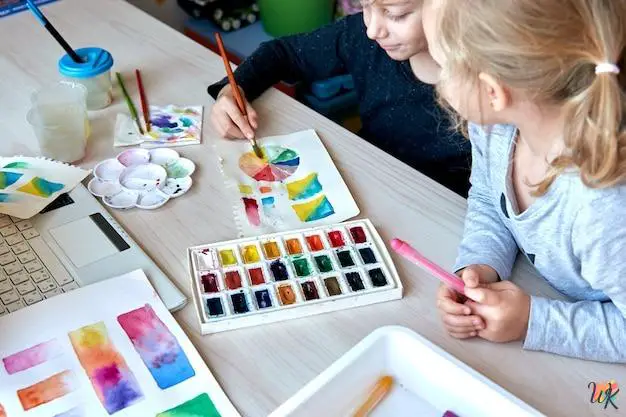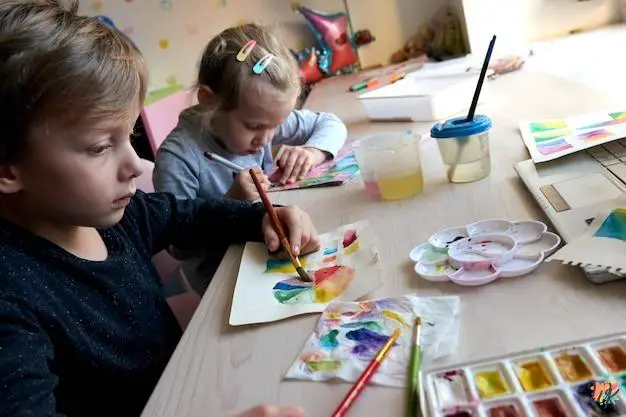Children’s painting is a wonderful form of self-expression and creativity. It allows young minds to explore their imagination, develop fine motor skills, and communicate their thoughts visually. One crucial aspect of children’s painting is understanding the basic drawing color scheme. By grasping the fundamental concepts of color, children can enhance their artwork and create visually appealing compositions. In this article, we will delve into the essential color schemes that can make children’s paintings come to life.

Introduction: The Importance of Color in Children’s Painting
Color is a fundamental element in any artwork, and it plays a significant role in children’s paintings too. Understanding how colors work together can greatly enhance a child’s artistic expression. By utilizing various color schemes, young artists can create visually engaging and balanced compositions that convey their intended messages effectively.
Primary Colors: The Building Blocks of Color
The foundation of all other colors is based on the primary colors. They include red, blue, and yellow. These colors cannot be created by mixing other colors together and are essential for children to learn. By understanding primary colors, children can easily grasp the concept of color mixing and explore the vast possibilities that lie within.
Secondary Colors: Mixing the Primary Colors
When the primary colors are mixed, they create the secondary colors: orange, green, and purple. Children can experiment with mixing these colors to expand their color palette and bring more vibrancy to their artwork. Exploring the world of secondary colors encourages children to unleash their creativity and discover new shades and tones.
Warm and Cool Colors: Creating Contrast and Emotion
Colors can evoke different emotions and moods. Warm colors such as red, orange, and yellow create a sense of energy, excitement, and warmth. On the other hand, cool colors like blue, green, and purple evoke calmness, tranquility, and serenity. By understanding the concept of warm and cool colors, children can convey specific emotions in their artwork and create visual contrast.
Complementary Colors: Harmonious Contrasts
Colors that are opposite to each other on the color wheel are referred to as complementary colors.When used together, they create a striking contrast that can make artwork visually appealing. For instance, red and green, or blue and orange are complementary colors. Encouraging children to experiment with complementary colors helps them understand how different colors can work harmoniously to create eye-catching compositions.
Analogous Colors: Blending Harmoniously
Colors that are next to each other on the color wheel are referred to as analogous colors. These colors share similar undertones and can create a harmonious and cohesive look in a painting. Analogous colors include red, orange, and yellow. Teaching children about analogous colors allows them to explore the subtleties of color blending and develop a sense of balance and harmony in their artwork.

Monochromatic Colors: Exploring Shades and Tones
Monochromatic colors are variations of a single color. By exploring shades, tints, and tones of a single hue, children can create depth and dimension in their artwork. Monochromatic paintings offer a unique opportunity for children to experiment with value and contrast, adding visual interest to their compositions.
Triadic Colors: Dynamic Compositions
Triadic colors are formed by selecting three colors that are equally spaced on the color wheel.This color scheme creates vibrant and visually engaging compositions. For instance, red, yellow, and blue are triadic colors. Introducing children to the concept of triadic colors enables them to explore dynamic color combinations and unleash their creativity.
Split Complementary Colors: Striking Balance
Split complementary colors are a variation of the complementary color scheme. Instead of using a single complementary color, children can choose a hue and combine it with the two adjacent colors to its complementary color. This creates a balanced composition with a slightly softer contrast, allowing young artists to experiment with different color harmonies.
Tetradic Colors: Vibrant Variety
Tetradic colors involve using four colors that are evenly spaced on the color wheel. This scheme offers a wide range of color possibilities, allowing children to create vibrant and diverse artworks. By encouraging children to explore tetradic colors, they can develop a deeper understanding of color relationships and exercise their artistic skills.
Color Psychology: Expressing Emotions through Colors
The use of colors can influence emotions and communicate various meanings. Red may symbolize passion and energy, while blue may represent tranquility and calmness. By teaching children about color psychology, they can better express their emotions and thoughts through their artwork. Understanding the emotional impact of colors adds depth and meaning to their creations.

Mixing and Experimenting with Colors: Encouraging Creativity
One of the best ways for children to learn about colors is through hands-on experimentation. Encourage children to mix different colors, observe the changes, and discover new shades and tones. By providing them with a variety of art materials and a safe space for exploration, children can unleash their creativity and develop a genuine passion for painting.
Tips for Using Colors in Children’s Painting
- Start with the primary colors and gradually introduce more color concepts.
- Allow children to explore and experiment with color mixing.
- Encourage children to observe and discuss the colors they see in their surroundings.
- Provide a variety of art materials to expand their color palette.
- Teach children about the emotions and messages associated with different colors.
- Display and appreciate their artwork to boost their confidence and motivation.
Common Mistakes to Avoid
- Using too many colors in a single artwork, resulting in a chaotic composition.
- Neglecting the importance of color harmony and balance.
- Overusing bright and intense colors, which can overpower the artwork.
- Failing to consider the emotional impact of colors in relation to the intended message.
- Discouraging experimentation and limiting children to rigid color rules.
Conclusion
Understanding the basic drawing color scheme is essential for children’s painting. By grasping the concepts of primary and secondary colors, warm and cool colors, complementary and analogous colors, and other color schemes, children can elevate their artwork and create visually captivating compositions. Encouraging experimentation, creativity, and an understanding of color psychology allows young artists to express themselves confidently through their paintings.

